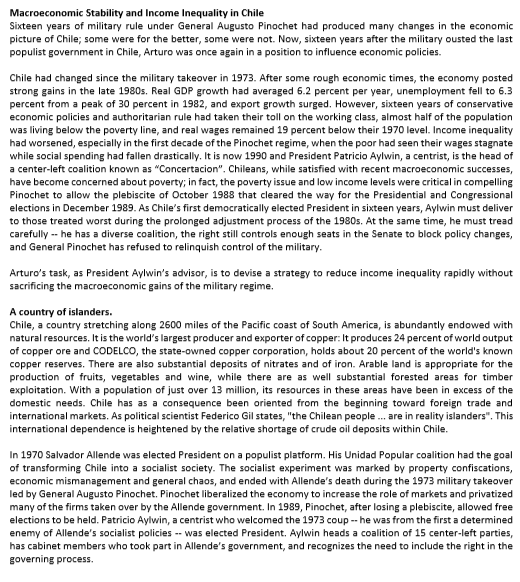
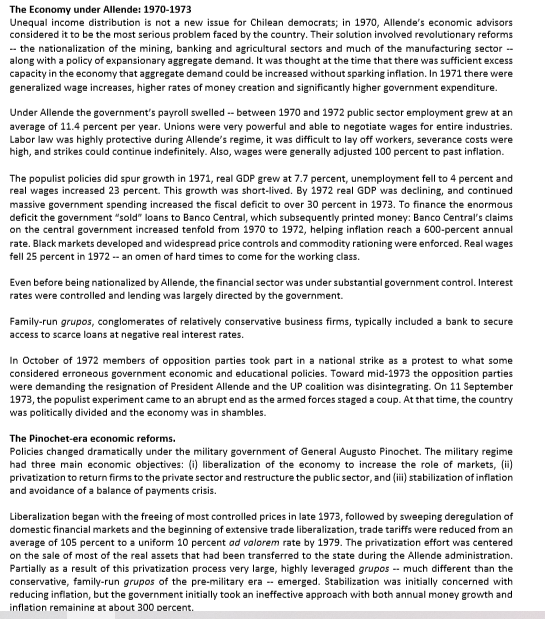
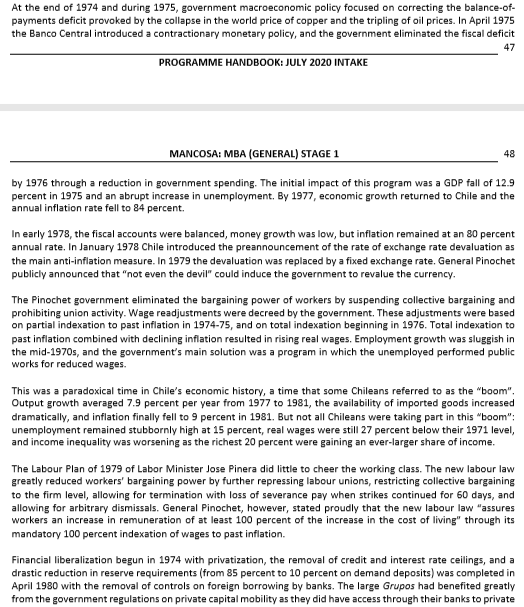
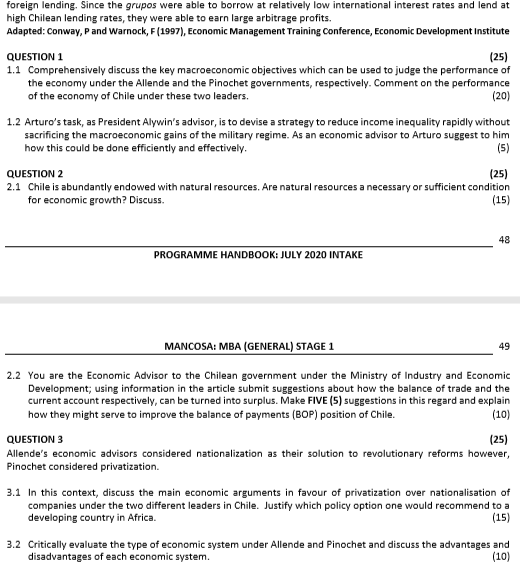
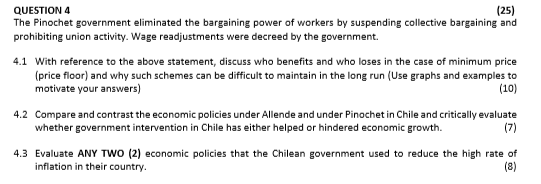
Macroeconomic Stability and Income Inequality in Chile Sixteen years of military rule under General Augusto Pinochet had produced many changes in the economic picture of Chile; some were for the better, some were not. Now, sixteen years after the military ousted the last populist government in Chile, Arturo was once again in a position to influence economic policies. Chile had changed since the military takeover in 1973. After some rough economic times, the economy posted strong gains in the late 1980s. Real GDP growth had averaged 6.2 percent per year, unemployment fell to 6.3 percent from a peak of 30 percent in 1982, and export growth surged. However, sixteen years of conservative economic policies and authoritarian rule had taken their toll on the working class, almost half of the population was living below the poverty line, and real wages remained 19 percent below their 1970 level. Income inequality had worsened, especially in the first decade of the Pinochet regime, when the poor had seen their wages stagnate while social spending had fallen drastically. It is now 1990 and President Patricio Aylwin, a centrist, is the head of a center-left coalition known as "Concertacion". Chileans, while satisfied with recent macroeconomic successes, have become concerned about poverty; in fact, the poverty issue and low income levels were critical in compelling Pinochet to allow the plebiscite of October 1988 that cleared the way for the Presidential and Congressional elections in December 1989. As Chile's first democratically elected President in sixteen years, Aylwin must deliver to those treated worst during the prolonged adjustment process of the 1980s. At the same time, he must tread carefully -- he has a diverse coalition, the right still controls enough seats in the Senate to block policy changes, and General Pinochet has refused to relinquish control of the military. Arturo's task, as President Aylwin's advisor, is to devise a strategy to reduce income inequality rapidly without sacrificing the macroeconomic gains of the military regime. A country of islanders. Chile, a country stretching along 2600 miles of the Pacific coast of South America, is abundantly endowed with natural resources. It is the world's largest producer and exporter of copper: It produces 24 percent of world output of copper ore and CODELCO, the state-owned copper corporation, holds about 20 percent of the world's known copper reserves. There are also substantial deposits of nitrates and of iron. Arable land is appropriate for the production of fruits, vegetables and wine, while there are as well substantial forested areas for timber exploitation. With a population of just over 13 million, its resources in these areas have been in excess of the domestic needs. Chile has as a consequence been oriented from the beginning toward foreign trade and international markets. As political scientist Federico Gil states, "the Chilean people... are in reality islanders". This international dependence is heightened by the relative shortage of crude oil deposits within Chile. In 1970 Salvador Allende was elected President on a populist platform. His Unidad Popular coalition had the goal of transforming Chile into a socialist society. The socialist experiment was marked by property confiscations, economic mismanagement and general chaos, and ended with Allende's death during the 1973 military takeover led by General Augusto Pinochet. Pinochet liberalized the economy to increase the role of markets and privatized many of the firms taken over by the Allende government. In 1989, Pinochet, after losing a plebiscite, allowed free elections to be held. Patricio Aylwin, a centrist who welcomed the 1973 coup -- he was from the first a determined enemy of Allende's socialist policies -- was elected President. Aylwin heads a coalition of 15 center-left parties, has cabinet members who took part in Allende's government, and recognizes the need to include the right in the governing process. The Economy under Allende: 1970-1973 Unequal income distribution is not a new issue for Chilean democrats; in 1970, Allende's economic advisors considered it to be the most serious problem faced by the country. Their solution involved revolutionary reforms - the nationalization of the mining, banking and agricultural sectors and much of the manufacturing sector -- along with a policy of expansionary aggregate demand. It was thought at the time that there was sufficient excess capacity in the economy that aggregate demand could be increased without sparking inflation. In 1971 there were generalized wage increases, higher rates of money creation and significantly higher government expenditure. Under Allende the government's payroll swelled -- between 1970 and 1972 public sector employment grew at an average of 11.4 percent per year. Unions were very powerful and able to negotiate wages for entire industries. Labor law was highly protective during Allende's regime, it was difficult to lay off workers, severance costs were high, and strikes could continue indefinitely. Also, wages were generally adjusted 100 percent to past inflation. The populist policies did spur growth in 1971, real GDP grew at 7.7 percent, unemployment fell to 4 percent and real wages increased 23 percent. This growth was short-lived. By 1972 real GDP was declining, and continued massive government spending increased the fiscal deficit to over 30 percent in 1973. To finance the enormous deficit the government "sold" loans to Banco Central, which subsequently printed money: Banco Central's claims on the central government increased tenfold from 1970 to 1972, helping inflation reach a 600-percent annual rate. Black markets developed and widespread price controls and commodity rationing were enforced. Real wages fell 25 percent in 1972 -- an omen of hard times to come for the working class. Even before being nationalized by Allende, the financial sector was under substantial government control. Interest rates were controlled and lending was largely directed by the government. Family-run grupos, conglomerates of relatively conservative business firms, typically included a bank to secure access to scarce loans at negative real interest rates. In October of 1972 members of opposition parties took part in a national strike as a protest to what some considered erroneous government economic and educational policies. Toward mid-1973 the opposition parties were demanding the resignation of President Allende and the UP coalition was disintegrating. On 11 September 1973, the populist experiment came to an abrupt end as the armed forces staged a coup. At that time, the country was politically divided and the economy was in shambles. The Pinochet-era economic reforms. Policies changed dramatically under the military government of General Augusto Pinochet. The military regime had three main economic objectives: (i) liberalization of the economy to increase the role of markets, () privatization to return firms to the private sector and restructure the public sector, and (iii) stabilization of inflation and avoidance of a balance of payments crisis. Liberalization began with the freeing of most controlled prices in late 1973, followed by sweeping deregulation of domestic financial markets and the beginning of extensive trade liberalization, trade tariffs were reduced from an average of 105 percent to a uniform 10 percent od valorem rate by 1979. The privatization effort was centered on the sale of most of the real assets that had been transferred to the state during the Allende administration. Partially as a result of this privatization process very large, highly leveraged grupos -- much different than the conservative, family-run grupos of the pre-military era -- emerged. Stabilization was initially concerned with reducing inflation, but the government initially took an ineffective approach with both annual money growth and inflation remainine at about 300 percent. At the end of 1974 and during 1975, government macroeconomic policy focused on correcting the balance-of- payments deficit provoked by the collapse in the world price of copper and the tripling of oil prices. In April 1975 the Banco Central introduced a contractionary monetary policy, and the government eliminated the fiscal deficit 47 PROGRAMME HANDBOOK: JULY 2020 INTAKE MANCOSA: MBA (GENERAL) STAGE 1 48 by 1976 through a reduction in government spending. The initial impact of this program was a GDP fall of 12.9 percent in 1975 and an abrupt increase in unemployment. By 1977, economic growth returned to Chile and the annual inflation rate fell to 84 percent. In early 1978, the fiscal accounts were balanced, money growth was low, but inflation remained at an 80 percent annual rate. In January 1978 Chile introduced the preannouncement of the rate of exchange rate devaluation as the main anti-inflation measure. In 1979 the devaluation was replaced by a fixed exchange rate. General Pinochet publicly announced that "not even the devil" could induce the government to revalue the currency. The Pinochet government eliminated the bargaining power of workers by suspending collective bargaining and prohibiting union activity. Wage readjustments were decreed by the government. These adjustments were based on partial indexation to past inflation in 1974-75, and on total indexation beginning in 1976. Total indexation to past inflation combined with declining inflation resulted in rising real wages, Employment growth was sluggish in the mid-1970s, and the government's main solution was a program in which the unemployed performed public works for reduced wages. This was a paradoxical time in Chile's economic history, a time that some Chileans referred to as the "boom", Output growth averaged 7.9 percent per year from 1977 to 1981, the availability of imported goods increased dramatically, and inflation finally fell to 9 percent in 1981. But not all Chileans were taking part in this "boom": unemployment remained stubbornly high at 15 percent, real wages were still 27 percent below their 1971 level, and income inequality was worsening as the richest 20 percent were gaining an ever-larger share of income. The Labour Plan of 1979 of Labor Minister Jose Pinera did little to cheer the working class. The new labour law greatly reduced workers' bargaining power by further repressing labour unions, restricting collective bargaining to the firm level, allowing for termination with loss of severance pay when strikes continued for 60 days, and allowing for arbitrary dismissals. General Pinochet, however, stated proudly that the new labour law "assures workers an increase in remuneration of at least 100 percent of the increase in the cost of living" through its mandatory 100 percent indexation of wages to past inflation Financial liberalization begun in 1974 with privatization, the removal of credit and interest rate ceilings, and a drastic reduction in reserve requirements (from 85 percent to 10 percent on demand deposits) was completed in April 1980 with the removal of controls on foreign borrowing by banks. The large Grupos had benefited greatly from the government regulations on private capital mobility as they did have access through their banks to private foreign lending. Since the grupos were able to borrow at relatively low international interest rates and lend at high Chilean lending rates, they were able to earn large arbitrage profits. Adapted: Conway, P and Warnock, F (1997), Economic Management Training Conference, Economic Development Institute QUESTION 1 (25) 1.1 Comprehensively discuss the key macroeconomic objectives which can be used to judge the performance of the economy under the Allende and the Pinochet governments, respectively. Comment on the performance of the economy of Chile under these two leaders. (20) 1.2 Arturo's task, as President Alywin's advisor, is to devise a strategy to reduce income inequality rapidly without sacrificing the macroeconomic gains of the military regime. As an economic advisor to Arturo suggest to him how this could be done efficiently and effectively. (5) QUESTION 2 (25) 2.1 Chile is abundantly endowed with natural resources. Are natural resources a necessary or sufficient condition for economic growth? Discuss. (15) 48 PROGRAMME HANDBOOK: JULY 2020 INTAKE 49 (10) QUESTION 3 MANCOSA: MBA (GENERAL) STAGE 1 2.2 You are the Economic Advisor to the Chilean government under the Ministry of Industry and Economic Development; using information in the article submit suggestions about how the balance of trade and the current account respectively, can be turned into surplus. Make FIVE (5) suggestions in this regard and explain how they might serve to improve the balance of payments (BOP) position of Chile. (25) Allende's economic advisors considered nationalization as their solution to revolutionary reforms however, Pinochet considered privatization. 3.1 In this context, discuss the main economic arguments in favour of privatization over nationalisation of companies under the two different leaders in Chile. Justify which policy option one would recommend to a developing country in Africa. (15) 3.2 Critically evaluate the type of economic system under Allende and Pinochet and discuss the advantages and disadvantages of each economic system. (10) QUESTION 4 (25) The Pinochet government eliminated the bargaining power of workers by suspending collective bargaining and prohibiting union activity. Wage readjustments were decreed by the government. 4.1 With reference to the above statement, discuss who benefits and who loses in the case of minimum price (price floor) and why such schemes can be difficult to maintain in the long run (Use graphs and examples to motivate your answers) (10) 4.2 Compare and contrast the economic policies under Allende and under Pinochet in Chile and critically evaluate whether government intervention in Chile has either helped or hindered economic growth. (7) 4.3 Evaluate ANY TWO (2) economic policies that the Chilean government used to reduce the high rate of inflation in their country. (8)











